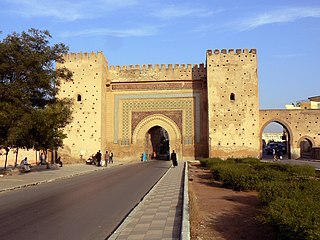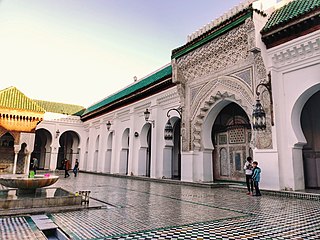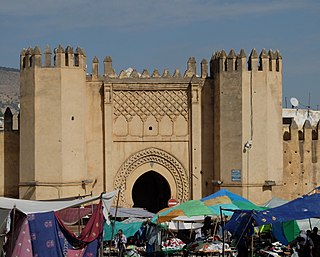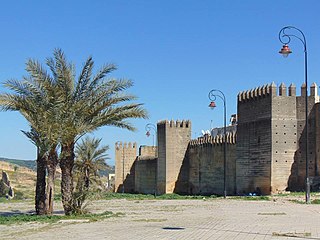
Place Bou Jeloud (also spelled Boujloud or Bu Jeloud), also known as Place Pacha el-Baghdadi, [1] is a large public square in Fes, Morocco, located west of Bab Bou Jeloud gate.

Place Bou Jeloud (also spelled Boujloud or Bu Jeloud), also known as Place Pacha el-Baghdadi, [1] is a large public square in Fes, Morocco, located west of Bab Bou Jeloud gate.
Bou Jeloud, the square's historical name, is also associated with the former kasbah (citadel) on its southern side and to the famous city gate to its east today. The name "Bou Jeloud" (or Bou Jloud) is reportedly a vernacular corruption of the expression Abu al-Junud ("father of the troops"), referring to a military parade ground. [2] [3]
Today the square is also named after Pasha Si Mohammed Ben Bouchta El Baghdadi, the officer who was placed in charge of Fes during the first 20 years of the French Protectorate between 1912 and his death in 1932. [4]
The square likely dates from the Almohad period (early 13th century) when most of the surrounding fortifications were constructed by Muhammad al-Nasir. [1] It was originally used as military parade ground and staging area but was also used as a camping ground for caravans and as a promenade and entertainment ground in the evenings. [2] On the south side of the square was the Kasbah Bou Jeloud, a formerly walled compound that was occupied by the authorities and by the governor of Fes from the Almohad period to the 20th century, but which today is a common neighbourhood. [2]
For a long time, the middle of the square was occupied by a large, rectangular, Marinid-era building that served as stables and was known as the Herri Bou Jloud. [2] The city walls on the western side of the square, adjoining the city's main western gate, Bab Mahrouk, were also lined with small chambers or shelters for the soldiers who kept watch at night, while the northern and eastern parts of the square were also occupied by miscellaneous structures such as warehouses and a marabout's tomb. [2]

The square is bordered by Bab Mahrouk and the city walls of Fes el Bali to the west, by the Kasbah en-Nouar to the north (including the Bab Chorfa gate), and by the former Kasbah Bou Jeloud to the south. To the south today is also the Lycée Moulay Idris, Morocco's first "modern" secondary school, founded in 1917. [3] The Bou Jeloud Mosque, established in the Almohad period, also stands nearby to the southeast, on the site of the former Kasbah Bou Jeloud. [5]
Today the square is still used for various events, such as one of the venues for the World Sacred Music Festival. [6] The northern part of the square, in front of Bab Chorfa gate, is the site of a long-running open-air market selling low-cost goods to local residents. [2] : 395
As of 2022, the square was undergoing extensive renovation for the construction of a new large-scale parking facility that will serve the old city of Fes. [7] [8]

Meknes is one of the four Imperial cities of Morocco, located in northern central Morocco and the sixth largest city by population in the kingdom. Founded in the 11th century by the Almoravids as a military settlement, Meknes became the capital of Morocco under the reign of Sultan Moulay Ismaïl (1672–1727), son of the founder of the Alaouite dynasty. Moulay Ismaïl created a massive imperial palace complex and endowed the city with extensive fortifications and monumental gates. The city recorded a population of 632,079 in the 2014 Moroccan census. It is the seat of Meknès Prefecture and an important economic pole in the region of Fès-Meknès.

Moroccan architecture reflects Morocco's diverse geography and long history, marked by successive waves of settlers through both migration and military conquest. This architectural heritage includes ancient Roman sites, historic Islamic architecture, local vernacular architecture, 20th-century French colonial architecture, and modern architecture.

Fes el Bali is the oldest walled part of Fez, Morocco. Fes el Bali was founded as the capital of the Idrisid dynasty between 789 and 808 AD. UNESCO listed Fes el Bali, along with Fes Jdid, as a World Heritage Site in 1981 under the name Medina of Fez. The World Heritage Site includes Fes el Bali's urban fabric and walls as well as a buffer zone outside of the walls that is intended to preserve the visual integrity of the location. Fes el Bali is, along with Fes Jdid and the French-created Ville Nouvelle or “New Town”, one of the three main districts in Fez.

The Kasbah of the Udayas, also spelled Kasbah of the Oudaias or of the Oudayas, is a kasbah (citadel) in Rabat, Morocco. It is located on a hill at the mouth of the Bou Regreg opposite Salé, and adjacent to the Medina quarter of Rabat. It is listed, along with other sites in Rabat, as a UNESCO World Heritage Site.

Fez or Fes is a city in northern inland Morocco and the capital of the Fès-Meknès administrative region. It is the second largest city in Morocco, with a population of 1.11 million according to the 2014 census. Located to the north west of the Atlas Mountains, it is surrounded by hills and the old city is centered around the Fez River flowing from west to east.

Bab Bou Jeloud is an ornate city gate in Fes el Bali, the old city of Fez, Morocco. The current gate was built by the French colonial administration in 1913 to serve as the grand entrance to the old city.

The Kasbah An-Nouar or Kasbah Filali is a walled district and former military enclosure in the old medina of Fez, Morocco. Its name means "citadel of the flowers", but it is sometimes also referred to as Kasbah Filala and Kasbah Chorfa. It is one of several fortified military enclosures or kasbahs that were built around the old city of Fez across different periods.

The Royal Palace or Dar al-Makhzen is the palace of the King of Morocco in the city of Fez, Morocco. Its original foundation dates back to the foundation of Fes el-Jdid, the royal citadel of the Marinid dynasty, in 1276 CE. Most of the palace today dates from the 'Alawi era. The vast grounds are home to multiple private structures, patios, and gardens, but historically also included administrative offices and government tribunals. Today, the most publicly visible parts of the palace are its main entrances at the Old Mechouar and the highly ornate 20th-century gates at Place des Alaouites, near the Mellah.

The Fortifications of Fez comprise a complex circuit of ramparts and gates surrounding Fes el-Bali and Fes el-Jdid, two urban agglomerations that compose the old "medina" of Fes, Morocco. They also include a number of kasbahs (citadels) and forts which were built both to protect and to control the city. These fortifications have been built up over many centuries and the extensive remnants today date from many different periods.

The architecture of Fez, Morocco, reflects the wider trends of Moroccan architecture dating from the city's foundation in the late 8th century and up to modern times. The old city (medina) of Fes, consisting of Fes el-Bali and Fes el-Jdid, is notable for being an exceptionally well-preserved medieval North African city and is classified as a UNESCO World Heritage Site. A large number of historic monuments from different periods still exist in it today, including mosques, madrasas, synagogues, hammams (bathhouses), souqs (markets), funduqs (caravanserais), defensive walls, city gates, historic houses, and palaces.

Bab Oudaya, also known as Bab Lakbir or Bab al-Kabir, is the monumental gate of the Kasbah of the Udayas in Rabat, Morocco. The gate, built in the late 12th century, is located at the northwest corner of the Kasbah, uphill from the medina of Rabat. It is often cited as one of the most beautiful gates of Almohad and Moroccan architecture.

Tala'a Kebira is one of the longest and most important streets in Fes el-Bali, the old city (medina) of Fes, Morocco. The street runs roughly east to west, starting near the Bab Bou Jeloud and Bab Mahrouk gates in the west and ending at the al-Attarine Madrasa in the east, near the Qarawiyyin Mosque. It constitutes one of the main souq streets in the old city and a number of important historic monuments are built along it.

Bab Mahrouk, also spelled Bab Mahruq, is historically the main western city gate of Fes el Bali, the old walled city of Fes, Morocco. The gate dates from 1204 and is located on the northwestern corner of Place Bou Jeloud, near the edge of Kasbah an-Nouar. It was historically the approximate starting point of the old city's main street, Tala'a Kebira.

Bab Ftouh is the main southeastern gate of Fes el-Bali, the old walled city of Fes, Morocco.

The Bou Jeloud Mosque is a historic Almohad-era mosque in the former Kasbah of Bou Jeloud, located near Bab Bou Jeloud, in Fes, Morocco.

The Oued Fes or Fez River is a river in Morocco. It is a tributary of the Sebou River and historically the main source of water for the city of Fes, after which it is named.

The Kasbah of Marrakesh is a large walled district in the southern part of the medina of Marrakesh, Morocco, which historically served as the citadel (kasbah) and royal palace complex of the city. A large part of the district is still occupied by the official royal palace, the Dar al-Makhzen, which serves as the residence of the King of Morocco when he visits the city. The rest of the district consists of various neighbourhoods and monuments. It was founded by the Almohads in the late 12th century, with most of the construction carried out by Caliph Ya'qub al-Mansur. Two of its most important surviving structures today, the Kasbah Mosque and the main gate of Bab Agnaou, date from al-Mansur's reign.

The Kasbah of Moulay Ismail is a vast palace complex and royal kasbah (citadel) built by the Moroccan sultan Moulay Isma'il ibn Sharif in Meknes, Morocco. It is also known, among other names, as the Imperial City or Palaceof Moulay Ismail, or the Kasbah of Meknes. It was built by Moulay Isma'il over the many decades of his reign between 1672 and 1727, when he made Meknes the capital of Morocco, and received occasional additions under later sultans.

The History of Fez begins with its foundation by Idris I and Idris II at the end of the 8th century and the beginning of the 9th century CE. It initially consisted of two autonomous and competing settlements on opposing shores of what is now known as the Oued Fes. Initially inhabited by a largely Berber (Amazigh) population, successive waves of mainly Arab immigrants from Ifriqiya (Tunisia) and al-Andalus (Spain/Portugal) over time gave the nascent city an Arab character as well. After the downfall of the Idrisid dynasty, it was contested between different Zenata groups allied with either the Fatimid Caliphate or the Umayyad Caliphate of Cordoba. In the 11th century the Almoravid sultan Yusuf ibn Tashfin conquered the region and united its two settlements into what is today the Fes el-Bali quarter. Under the rule of the Almoravids and of the Almohads after them, despite losing the status of capital to Marrakesh, the city remained the economic and political center of northern Morocco and gained a reputation for religious scholarship and mercantile activity.